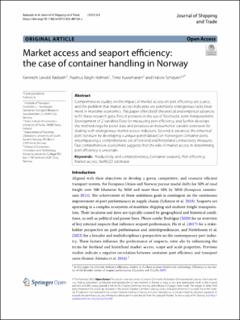| dc.contributor.author | Rødseth, Kenneth Løvold | |
| dc.contributor.author | Holmen, Rasmus Bøgh | |
| dc.contributor.author | Kuosmanen, Timo | |
| dc.contributor.author | Schøyen, Halvor | |
| dc.coverage.spatial | Oslo, Norway | en_US |
| dc.date.accessioned | 2023-06-13T07:05:36Z | |
| dc.date.available | 2023-06-13T07:05:36Z | |
| dc.date.created | 2023-04-12T11:15:06Z | |
| dc.date.issued | 2023-04-10 | |
| dc.identifier.citation | Journal of Shipping and Trade. 2023, 8 1-25. | en_US |
| dc.identifier.issn | 2364-4575 | |
| dc.identifier.uri | https://hdl.handle.net/11250/3071035 | |
| dc.description | Open Access This article is licensed under a Creative Commons Attribution 4.0 International License, which permits use, sharing, adaptation, distribution and reproduction in any medium or format, as long as you give appropriate credit to the original author(s) and the source, provide a link to the Creative Commons licence, and indicate if changes were made. The images or other third party material in this article are included in the article’s Creative Commons licence, unless indicated otherwise in a credit line to the material. If material is not included in the article’s Creative Commons licence and your intended use is not permitted by statutory regulation or exceeds the permitted use, you will need to obtain permission directly from the copyright holder. To view a copy of this licence, visit http://creativecommons.org/licenses/by/4.0/ | en_US |
| dc.description.abstract | Comprehensive studies on the impact of market access on port efficiency are scarce, and the problem that market access indicators are potentially endogenous lacks treatment in maritime economics. This paper offers both theoretical and empirical advances to fill these research gaps. First, it pioneers in the use of Stochastic semi-Nonparametric Envelopment of Z variables Data for measuring port efficiency, and further develops the methodology for panel data and proposes an instrumental variable extension for dealing with endogenous market access indicators. Second, it advances the empirical port literature by developing a unique panel dataset on Norwegian container ports encompassing a comprehensive set of foreland and hinterland connectivity measures. Our comprehensive assessment suggests that the role of market access in determining port efficiency is uncertain. | en_US |
| dc.description.abstract | Market access and seaport efficiency: the case of container handling in Norway | en_US |
| dc.language.iso | eng | en_US |
| dc.publisher | SpringerOpen | en_US |
| dc.title | Market access and seaport efficiency: the case of container handling in Norway | en_US |
| dc.title.alternative | Market access and seaport efficiency: the case of container handling in Norway | en_US |
| dc.type | Journal article | en_US |
| dc.type | Peer reviewed | en_US |
| dc.rights.holder | © The Author(s) 2023 | en_US |
| dc.description.version | publishedVersion | en_US |
| cristin.ispublished | true | |
| cristin.fulltext | original | |
| cristin.qualitycode | 1 | |
| dc.identifier.doi | 10.1186/s41072-023-00134-z | |
| dc.identifier.cristin | 2140238 | |
| dc.source.journal | Journal of Shipping and Trade | en_US |
| dc.source.volume | 8 | en_US |
| dc.source.pagenumber | 1-25 | en_US |
| dc.relation.project | Norges forskningsråd: 267697 | en_US |
| dc.relation.project | Norges forskningsråd: 107957 | en_US |
